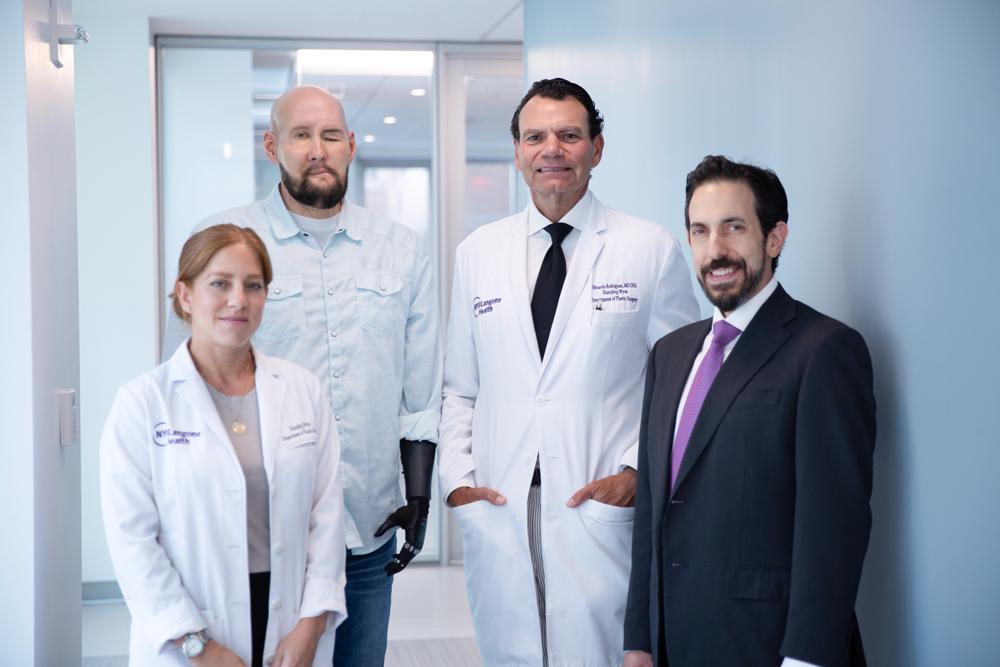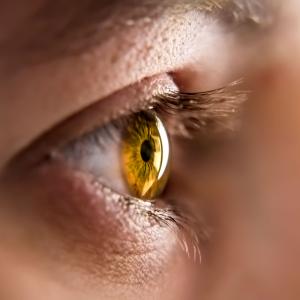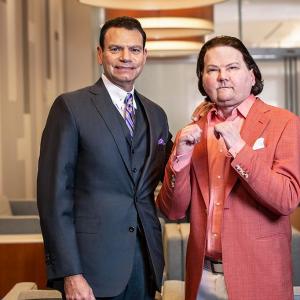A Study Published in JAMA Reports on the Eye’s Functioning, Without Sight but Offering Hope for the Future

Over a year after a whole-eye and partial-face transplant, Aaron James has made a remarkable recovery, back to daily life in Arkansas.
A surgical team at NYU Langone Health performed the world’s first whole-eye and partial-face transplant in May 2023 for 46-year-old military veteran Aaron James, who had survived a high-voltage electrical accident at work. Over a year later, James has made a remarkable recovery and is back to daily life in Arkansas.
A study published September 9 in the Journal of the American Medical Association (JAMA) reveals clinical outcomes and discoveries from the past year. Notably, the transplanted donor eye has maintained normal pressure and blood flow over time, contrary to findings from animal models of whole-eye transplants, where the eye often shrank significantly. Although the transplanted eye has not regained vision, electroretinography—a test that measures the retina’s electrical response to light—shows a photoreceptor response, indicating that rods and cones, the light-sensitive nerve cells in the eye, survived the transplant. This electrical response converts light into signals that ultimately the brain could interpret for vision, giving hope for the future of whole-eye transplants with an aim to restore sight.
“Our discoveries over the past year mark promising initial results, laying a foundation for further advancements and ongoing research,” said Eduardo D. Rodriguez, MD, DDS, who was senior author on the study, and the surgeon who led a team of more than 140 medical professionals who collaborated on the procedure. “We are truly amazed by Aaron’s recovery, with no episodes of rejection. Our methodical approach to the matching process, ensuring that Aaron received the most favorable donor match, along with our unique immunosuppression regimen, has set the standard for eliminating and avoiding early rejection episodes.” Dr. Rodriguez is director of the Face Transplant Program and the Laura and Isaac Perlmutter Cosmetic Plastic Surgery Center. He is also the Helen L. Kimmel Professor of Reconstructive Plastic Surgery, and chair of the Hansjörg Wyss Department of Plastic Surgery at NYU Grossman School of Medicine.
Learn more about the JAMA study findings and Aaron James’s recovery, one year after surgery.
Interviews and Multimedia Materials Available
Interviews and multimedia materials, including progress photos and B-roll package, are available by emailing Kathryn.Ullman@NYULangone.org.
The JAMA study, led by Dr. Rodriguez and his colleagues in the Hansjörg Wyss Department of Plastic Surgery, the Departments of Ophthalmology and Radiology, and NYU Langone’s Transplant Institute, details the 21-hour surgery that utilized innovative microsurgical techniques, customized surgical devices, and cell-based therapies. This procedure included the first attempt in injecting stem cells into a human optic nerve during transplant, aiming to enhance nerve regeneration. The team also notes the challenges of a combined whole-eye and partial-face transplant but demonstrates that the procedure can restore important functions and structures for the patient.
The study also reports the results of clinical tests on the transplanted donor eye conducted over the past year, using various evaluation methods. The examinations showed several hopeful results, including normal eye pressure, good blood flow in the eye, and some remaining structure in the retina.
However, there has been no ability to see light, and noticeable damage to the optic nerve has resulted in some loss of retinal tissue as the eye recovered. The authors note that further testing is needed to draw more definitive conclusions from these initial measurements.
“Our study is the first to show the feasibility of whole-eye transplant in conjunction with a face transplant,” said Vaidehi S. Dedania, MD, Aaron’s ophthalmologist and a retina specialist in the Department of Ophthalmology. “The outcomes we’re seeing after this procedure are quite incredible and could pave the way for new clinical protocols and inspire further research into complex transplants involving critical sensory organs.”
A Year of Milestones: From Rediscovering Simply Joys to Embracing a New Identity
For James, the highlights of the past year have been marked by milestones most people take for granted: no more stares from strangers, the ability to enjoy solid foods again, and even the simple pleasures of smelling. Now, he can focus on what matters most—sending his daughter, Allie, off to college.
“I’m pretty much back to being a normal guy, doing normal things,” said James. “All in all, though, this has been the most transformative year of my life. I’ve been given the gift of a second chance, and I don’t take a single moment for granted.”
One accomplishment James eagerly anticipated was a recent visit to the DMV to finally replace his driver’s license. Trading in the old license, which displayed his injured face, for one that reflects his new identity moved the DMV worker to tears.
“The aesthetic outcomes and quality of life this procedure has provided to Aaron should not be overshadowed,” said Daniel J. Ceradini, MD, the study’s first author, who is director of research and an associate professor in the Hansjörg Wyss Department of Plastic Surgery. “He has regained many elements of life he lost after the 2021 injury, and that’s our ultimate goal.”
James continues regular follow-up appointments at NYU Langone and feels proud to be a part of such transformative research. “I have felt honored to be patient zero. Even if I can’t see out of my new eye, I’ve gained my quality of life back, and I know this is a step forward in the path to help future patients,” said James.
Looking Ahead to the Next Frontier of Vision Restoration
Vision loss affects over 7 million Americans. Although therapies exist to slow its progression, none currently restore sight. Whole-eye transplants to restore vision have remained elusive due to the complex nature of the eye. The difficulties include maintaining retinal blood flow, preventing immune rejection, preserving how the eye responds to light, and ensuring the nerves and connections to the brain regrow and make functional connections to the brain.
“The first challenge is successfully transplanting an entire eye into a new human and keeping that eye alive without rejection—a feat Dr. Rodriguez and the NYU Langone team have achieved,” said Paul W. Glimcher, PhD, director of NYU Langone’s Neuroscience Institute and chair of the Department of Neuroscience and Physiology. “The next hurdle is preserving the nerve cells in the eye during the transplant process, and in this case, it’s remarkable that some parts of the retina have survived over the past year. The critical task ahead is to ensure that all of the eye cells survive the transplant, which is essential for restoring connections to the brain. That is the fundamental requirement for vision, as sight is primarily a function of the brain, not just the eyes.”
The human eye is connected to the brain through the optic nerve, part of the central nervous system and responsible for transmitting visual information to the brain. The researchers will continue the journey with James through uncharted territory in medical science.
“We’ve done the work to transplant an eye. We now need to do more work in understanding how to restore sight to the eye,” said Dr. Rodriguez. “We look forward to continuing this research in collaboration across academia to accelerate these discoveries with unique tools and the best therapies.”
Other NYU Langone study authors were David L. Tran, MD, plastic surgery resident; Bruce E. Gelb, MD, from the Transplant Institute and the Department of Surgery; Oriana D. Cohen, MD; Roberto L. Flores, MD; Jamie P. Levine, MD; Pierre B. Saadeh, MD; David A. Staffenberg, MD; Zakia Ben Youss, BTech; Patryk Filipiak, PhD, research scientist in the Center for Advanced Imaging Innovation and Research; and Steven H. Baete, PhD, from the Department of Radiology.
The authors would like to thank the following: all those at NYU Langone who made this endeavor possible; LiveOnNY, the organ procurement organization for the greater New York metropolitan area; DePuy Synthes and Materialise for assistance in instrumentation, device design, and fabrication; LaGuardia Studio at New York University for printing donor prosthetics; the donor and donor family for their gift of life; and the patient, Aaron James.
The work was supported by NYU Langone Health and NYU Grossman School of Medicine. Magnetic resonance imaging tractography studies were supported by National Institutes of Health grants RO1 EB028774.
Media Inquiries
Katie Ullman
Phone: 646-483-3984
Kathryn.Ullman@NYULangone.org


